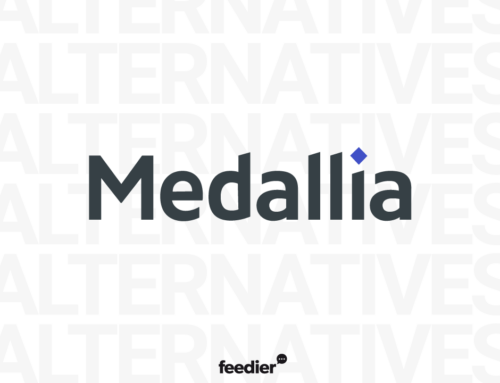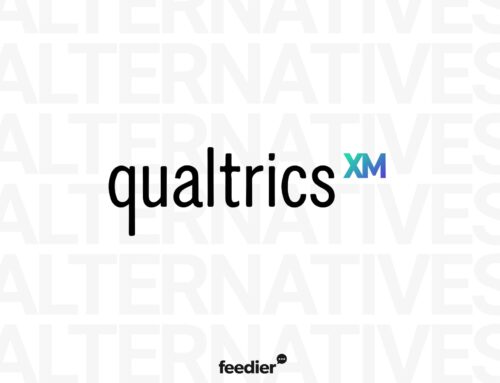What if I could improve my response rate by offering a survey incentive?
Persuading your users to fill out a survey is hard. Persuading enough users that you get acceptable response rates is even harder.
What if 100% of the customers would have filled my survey?
That would be fantastic.
As a rule of thumb, anything above 10% response rates will yield meaningful data.
But, what if your customers are simply not committed to providing you feedback?
Even if you have the best customers, sometimes, it is just the case that you are not getting any response to your survey.
Whether it is because your survey doesn’t really relate to your
How can you send out a survey without worrying about whether or not you’ll get back enough responses to make a solid conclusion about something?
Believe it or not, there’s a whole field dedicated to answering this one question.
A survey incentive is something that motivates or encourages someone to invest their time in a survey to the best of their ability. Incentives come in many forms.
How to Increase Survey Response Rate?
Before that, I suggest you to listen to Carlos, speaking about response rate:
Hopefully, you’ve tested survey experiences without the use of incentives.
In fact, certain factors on their own can do a great deal in convincing people to complete a survey.
Here are 10 recommendations to increase your survey response rate, those are inspired by a study done in 2017 examining factors that impact online survey response rates (Saleh & Bista, 2017, p. 71):
- Only target those who feel the effects of the subject matter most
- Make the survey short and concise
- Tell potential respondents how long it will take to complete in your invitation(s)
- Use authority figures or people in your organization who your users are actively following on social media to distribute the survey, when possible
- Use as little open-ended survey questions as possible
- Assure potential respondents of the anonymity and confidentiality of their responses
- Explain how the collected survey data will be handled, who will have access to it, and how the data will be stored if needed for future use
- Send professional and personalized invitations to participate in the survey
- Send at least one, but not more than three, reminders to your potential respondents
- Keep in mind time constraints in different professions based on time of year (e.g. accountants during tax time, teachers during exam season, etc.)
If you’ve done all of these things, it’s time to figure out which survey incentive would apply to your audience best.
What Is a Survey Incentive?
Once your respondent has fully completed the survey, you reward him or her with a voucher, some money, a file, some loyalty points, or anything of value.
The goal is to level the playing field and implement a two-way flow by rewarding our customers for their precious time and efforts.
On one hand, these incentives are meant to increase the response rate, as demonstrated in this study, and prove your willingness to value your respondents’ time.
But, on the other hand, they can also entail biased results, which you need to pay close attention to.
You need to pay attention to the target population.
You might face a type of population simply looking for “bounties”, avoid the incentives in this case.
Let’s talk about the different incentives.
Types of Survey Incentives to Increase The Response Rate
Most research on the topic of survey incentives has been focused on large, national surveys for social research (Singer, 2012, p. 4).
There haven’t been many academic studies on the topic of surveying online software customers, however, if you’re sending your survey to your email list, you have the advantage of recommendation #1:
Only target those who feel the effects of the subject matter most
Because you’re sending your survey to a list of people who are already giving you money, they have a vested interest in making sure that money is being put to good use.
Even so, you’ll need to make sure you incentivize your reader in such a way that you will get:
- Completed surveys
- Non-biased surveys
Let’s take a look at how each type of survey incentive affects respondents’ answers.
Non-Monetary Incentives
Just like you can motivate people with money, you can also motivate them with words.
But those words have to be framed in a way that uses that which motivates your reader most.
Whether it be guilt, health, knowledge, ease, or community, everyone is motivated by something other than money.

Non-monetary incentives are proven to work even better than monetary incentives in this 2009 meta-analysis wherein the authors found 32 eligible trials which evaluated 27 different ways to increase responses to online surveys:
The odds of response were increased by more than a half using non-monetary incentives
Edwards, et al., 2009
You can appeal to many sides of human nature. The ones listed below have been tested in different survey studies.
Appeal to Self-Interest
Like many copywriting greats have stated, you should write in a way that appeals to your reader’s self-interest. Tell your reader what he or she will get and that a lot of effort isn’t needed to get it.
For example, if you were to write something like this:
Help us make sure you get [burning problem] fixed
Got 5 mins to tell us how we’re missing something in [workflow issue]?
Tell us where you’re getting stuck in [workflow]
…then you’ll be getting their interest.
Why?
People are hard-wired to notice novelty and danger. So when you remind them that they’re in danger of falling behind in work, in danger of losing revenue, or in danger of something else that’s important, they will take action to eliminate that danger.
So aim for writing that makes your reader feel an impact.
A 2011 study on online surveys demonstrates that if you explain the importance of the survey results in terms of how it’ll impact the reader, then it’ll pack more of a punch than monetary incentives (Oppenheimer, Pannucci, Kasten, & Haase, 2011).
Appeal to Social Status
Human beings are social creatures.
As a result, we tend to compare ourselves with our colleagues, our friends, our family members, and more. We constantly strive to be better, not just better than we are today, but better than others. How do we find out if we’re doing any better?
We get curious.
That’s why offering someone a chance to see survey results is an excellent incentive if it’s the type that offers him/her information on how he or she is doing in comparison to his or her colleagues.
In fact, offering survey results increases odds of response by a third (Edwards, et al., 2009).
Examples include state of marketing reports, freelancer pricing guides, and short-term rental company revenues.
Here’s a snippet from Kevin Rogers from copychief.com, copywriting industry veteran:

Notice that Kevin includes the exact questions his target reader thinks about daily. That’s why you have to understand your target reader inside and out to be able to use this kind of incentive.
We have done the same at Feedier with our customer success survey. Asking for customer success pros to give us their opinion on the state of CS, and report them the results.

For example, if you have a SaaS that allows people to aggregate reviews from third-party sources, you might want to send out a survey to your email list asking questions around that topic.
Getting reviews is hard even when people love your service, so it’s likely that marketers would want to find out how their colleagues are doing in terms of:
- Reaching out to get reviews
- How often they get reviews
- How much of an impact reviews have on their business
All of these questions should be ones that both interest the reader and help you to make company decisions.
Appeal to Social Proof
This is a psychological principle of persuasion that Dr. Cialdini has talked about in many of his books.
It’s the concept that people are more likely to perform an action if someone else, or many people, have performed this action prior to them.
If you’ve ever read a software review, restaurant review, or movie review and then made your decision based off of those reviews, then you’ve felt the effects of social proof. It works because we like to be assured that something is socially acceptable.
The same is true with survey responses. When sending survey invitations, the odds of response increase by more than a half when “including a statement that others had responded (Edwards, et al., 2009)”.
Try using that on your second or third reminder.
Wouldn’t really make sense in your initial invitation, right?
Zest is a great example of that with their recent Zest experience survey. Karolis exactly use this principle of social proof, with the mention of the “351 Zesters” that have already replied to his survey.

Appeal to Fear of Missing Out
Another one of Dr. Cialdini’s psychological principles has proven results when it comes to getting more survey results. Because we’re attuned to the novel and the dangerous, we have a fear of missing out. The term Cialdini uses is scarcity.
You can see examples of this is terminology such as:
Sale’s almost over! Last chance to save 70%. Don’t want to be left in the dark? Join now!
3 hours left [Includes ominous stopwatch]
In the 2009 meta-analysis mentioned earlier, the authors found that odds of response increase with a deadline.
Reciprocity and How to Use it Correctly
You know that feeling when you’re clicking the invite button on a Facebook event and you get this obligation to invite someone who had invited you to a party months ago?
That’s the psychological principle of reciprocity kicking into effect.
It kicks into effect every time you feel obligated to give something back to someone who originally gave you something.
Many marketers use this principle incorrectly by mixing together two norms. They assume that if they’ve provided something free in the past, then it’s okay to ask for something in return. That’s one of the basics of gamification.
For that to work, that something in return has to be in the same category of norms.
Let me explain.
Dan Ariely, Professor of Psychology and Behavioral Economics, demonstrated in his book Predictably Irrational, that we’re governed both by social norms and market norms. The former is what allows us to give and receive anything other than money, freely. This could include our time, our knowledge, a reference, a backlink, etc. Anything other than money.
The latter is what allows us to pay for material goods, to have jobs, to get clients and customers, etc.

When we ask people who are already paying us money monthly to give us their time…
That gets dangerously close to the line between social and market norms. It’s dangerous because you’ve built a relationship with your customers. At first, it was one that existed within social norms:
She came onto your website. You asked her questions to find out more.
He gave you an email address. You gave him an ebook.
But then…this person made their first payment and entered the realm of the market norms.
You gave her access to software that helped her. She paid you money.
You gave him access to software that helped him. He paid you money.
Now you want to send a survey and expect their time for your answers.
Make sure that if you’re going to use this non-monetary survey incentive approach, don’t remind them that they’re a valued customer.
That’ll remind them more of the fact that they’re paying you money rather than the awesome fact that your software helps them avoid problems they previously had to deal with before using it.
Instead, assure them that their time gives you the resources you need to make their lives that much easier.
Financial or Monetary Incentives
There’s a reason I put monetary incentives below non-monetary incentives: so that you would try the latter before the former.
Also, the research on the topic of monetary incentives provides conflicting data.
There are 2 options available when it comes to monetary incentives:
- Prepaid – you send money or something costing money with your invitation, meaning your invitee will get the incentive either way
- Postpaid – you send money or something costing money after your invitee has completed the survey
Here’s what this study has to say about prepaid, postpaid, and lottery-based survey incentives:
The results indicate that prepaid incentives in web surveys seem to have no advantages concerning the willingness to participate, actual completion rates, and the share of incomplete response patterns when compared with postpaid incentives.
Furthermore, postpaid incentives show no advantages over no incentives. Finally, compared to no incentives, prize draws increase completion rates and also reduce various incomplete participation patterns.
- Prepaid incentive – no advantages over postpaid
- Postpaid incentive – no advantages over no incentive
- Lottery incentive – better than no incentives
This study also shows that there is no significant difference in completion rates in filling out a survey whether if someone knows about a $10 gift card or not.
A study done in 2017 however, shows that a $10 incentive is effective in increasing survey responses (Yu, et al., 2017).
In Web Survey Methodology, the authors state that:
Monetary incentives typically outperform non-monetary ones, as in Vehovar at al. (2009), where the prepaid cash incentive of €5 pushed the response rate up from 33% to 74%, while a gift (the gift was a wallet for coins) – sent with the invitation letter – of similar value had almost no effect
Callegaro, Manfreda, & Vehovar, 2015, p. 149
There is no perfect amount or value for a survey incentive, but there are different things that can help you determine the right amount:
- The budget and resources allocated to the survey: if you have a tight budget for the survey, you would be very limited in terms of what you could offer, and therefore, the potential impact of your monetary incentive.
- The method used to deliver the incentive: if you decide to go for the promised incentive type, you would want to properly filter your population entering the survey.
- The target of your survey: someone making $70/hour would not value $5 the same way as someone making $12/hour.
Lottery Incentives
While it would seem like people would want something absolute after taking a survey, studies show otherwise. It seems that people are more willing to do something provided there’s something bigger on the line they could win.
In this study, the researchers tested 4 different conditions that would test response rates: no incentive, lottery incentive, token incentive, and philanthropic donation incentive.
The lottery incentive performed best with a response rate of 44.39%.
The token incentive performed almost as well with 43.28% while the no incentive option performed better (36.24%) than the donation incentive with a response rate of 34.67%.
In the 2009 meta-analysis mentioned earlier, the odds of survey responses increased by a third using a lottery method.
The lottery option prevails again in a 2003 study that concludes lottery style incentives work best in terms of highest completion rates and highest data quality.
The authors make the hypothesis though that a prize drawing rather than a guaranteed reward is more effective because of how people have how come to expect the survey process to go:
Because many survey studies are not funded at levels that provide the opportunity for individual monetary incentives for each participant, many studies do rely heavily on prize drawings to encourage response. Therefore, it is possible that individuals have been socialized by this practice to anticipate the use of a prize drawing rather than an individual, guaranteed reward. This, too, could help to heighten the effect of trust—or distrust—as the case may be. Specifically, if individuals are socialized to expect a prize draw but receive a cash equivalent or promise of an equivalent, this may heighten feelings of doubt that they would actually receive the reward
Bosnjak & Tuten, 2003
Incentives & Gamification Examples in SaaS
G2 Crowd Survey & Reviews
I’ve never had an email recipient so adamant on giving me money in exchange for something as small as a review. It makes sense for G2Crowd considering their business is based solely off of reviews. Over the course of a year they’ve sent me 25+ emails varying from a $10 Starbucks gift card, a $10 Amazon gift card, a $15 Amazon gift card, and a $10 donation on my behalf. Check out these examples below:
Scarcity

Reciprocity

A Holiday Theme

What are Marketers Saying?
After asking a variety of different growth marketers on how they’ve tested incentives, many actually stuck with one method, which was either offering a monetary incentive or framing it in such a way that the respondent benefits from filling out the survey.
Lucas Mondora,
I’ve tested out a few different types of incentives. Depending on the company and budget, this ranges from: giving away free low-cost products or resources, product discounts, non-tangible incentives like giving users the opportunity to help steer the direction of the company with their input
He later explained what are the benefits of using survey incentives.
I found the free product incentive worked really well: I did this a few months ago, and rather ask people to take a survey, it was to get customers on a 45-minute interview, which I’ve found to be a much tougher sell. But out of the 100 emails we sent, we ended up getting over 70% response rate and had to turn quite a few people down. I think that the response rate was because people just loved the product so much and were happy to share their opinions.
But I’ve also found that discounts on products which tend to get repeat purchases (ie. supplements, SaaS) work extremely well as the user is likely going to purchase again, so they think to themselves “why not get a good discount on it
Eventbrite Survey
Using simple design and copy, Eventbrite goes for the appeal to self-interest. It also uses the recommendations listed at the beginning of the article such as letting your reader know how long it’ll take to fill out the survey.

When to Use Survey Incentives?
There is one thing to keep in mind: your use case may not need any incentive.
Let me explain you.
If you’re running a research survey or churn survey for instance, in order to get to know your audience, and find out what prevented them from going further, the incentive might come handy and wouldn’t impact the result much.
Besides this, if you’re targeting a population of “non-responders” or very busy people, it would come handy.
The same goes for a population which is not emotionally attached to your brand.
It would also make sense in case of a follow-up. If you haven’t received any response to your first request, you could follow-up and use a bounty in order to increase the number of respondents.
Note that the incentive could also be plugged-in the follow-up email, if you haven’t got any feedback with the first request.
However, if you’re running anything involving your customer satisfaction, offering incentives may harm the quality of the feedback you get.
As a matter of fact, the customer is more likely to give
Finally, if you decide to use an incentive, think about using a tool providing a restriction to one answer per device or user, which will avoid getting spammed by scammers who want to scrap money.
You can also decide to go the gamified way, by offering things like lottery tickets, or any kind of incentive that isn’t delivered to everyone, but based of a random probability.
Survey Incentives Ideas
Let’s cover some examples of customer incentives that you could use, based on your type of business and who your target is.
Gift Card Survey And Amazon Gift
Let’s say you’re running a premium application, it would make
On the same topic, if you’re running an online eCommerce business, you could give a voucher on the next order.
You’re not only giving back but also increasing your likeliness of seeing your customer again. We could also imagine offering an Amazon Gift Card, or any kind of similar Gift Card.
Guide Or E-book
We are seeing more and more businesses writing their piece of content relevant to their field.
Example: Fiverr writing about freelancing success. By simply not giving away for free, but asking for feedback first, you’re serving both your company and your customer’s interest.
An e-book is only one example, the point is to send a valuable file, document or book.
Money Voucher
Although you could feel like that one is costly, it is simply worth it! Feedback matters and they are worth money!
They allow you to grow and reduce your customer churn, therefore making money over time. You could for instance give away 10 bucks sent through Paypal . Cold cash is the most effective way.
Personalized Message
We could also imagine offering a prank, or a message to invite to a special event we’re running.
Whatever you choose for, it’s important to use the reward as a way to show the value you’re attaching to your customers’ voice.
This is an example of survey reward you can configure in Feedier.

Survey Incentive Legal
When it comes to offering reward, there are three main things to keep in mind:
- is it really necessary?
- is it an appropriate price?
- does it comply with lottery laws?
First, you must comply with privacy law when collecting, storing and using personal information (name, phone, email).
Survey incentives are completely legal, even in the B2B world. But there are requirements that differ by state and country, so make sure to check with a legal professional to verify that you aren’t breaking any rules.
Is the Prize Appropriate?
When offering an incentive, it is important to ensure that it isn’t going to bias your survey results.
For instance, if you offer a public transport voucher, you are going to get a disproportionate number of respondents who use public transport, and those who live in areas without access to public transport who might otherwise have participated, may not bother.
In a nutshell, your bounty must resonate, provide value to your end target.
Try to pick something that would be of value to all demographics and locations, but not to big of a value!
Key Takeaways
You can only find out what survey incentive works best if you understand your users.
What do they care most about? What can they afford to not care about? What do they wish they had more of?
If you’re not sure about them, feel free to test two different panels of people with different incentives, or no incentive, and
Offering an incentive is here to help the response rate, but mainly to make the experience more appealing and show your customers that you value their time!
Even if people who pay for your product have the same burning desires, motivations, etc. they all have different times that work best for them. That’s why surveys that have used reminders on top of incentives get higher response rates. Sometimes people want to help out immensely but by the time they open your email, click on the link, and load the survey, they’re at the front of a café line ordering their coffee having forgotten all about your survey.
Remember that a survey incentive is just one piece of the puzzle.
No matter how enticing the incentive, it’s less likely you’ll get complete or accurate survey responses if the survey takes too long to complete.
As the great William Zinsser in On Writing Well states: “Omit needless words.” Or rather in this case: Omit needless questions.
It’s the overall experience that gets people from reading your subject line to hitting the “Finish” button.







